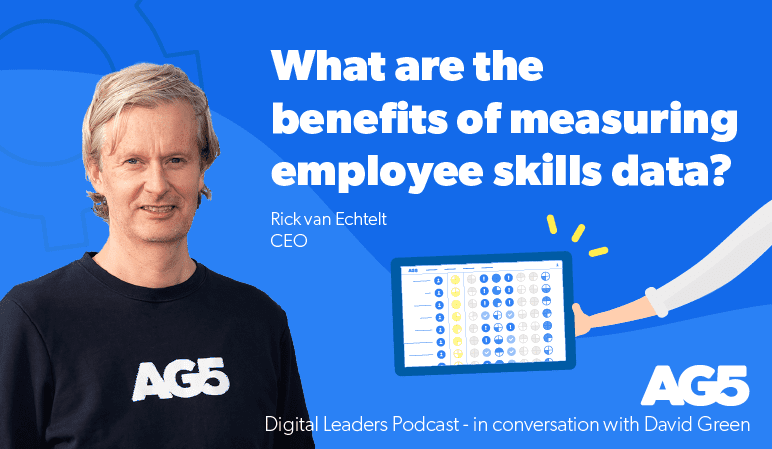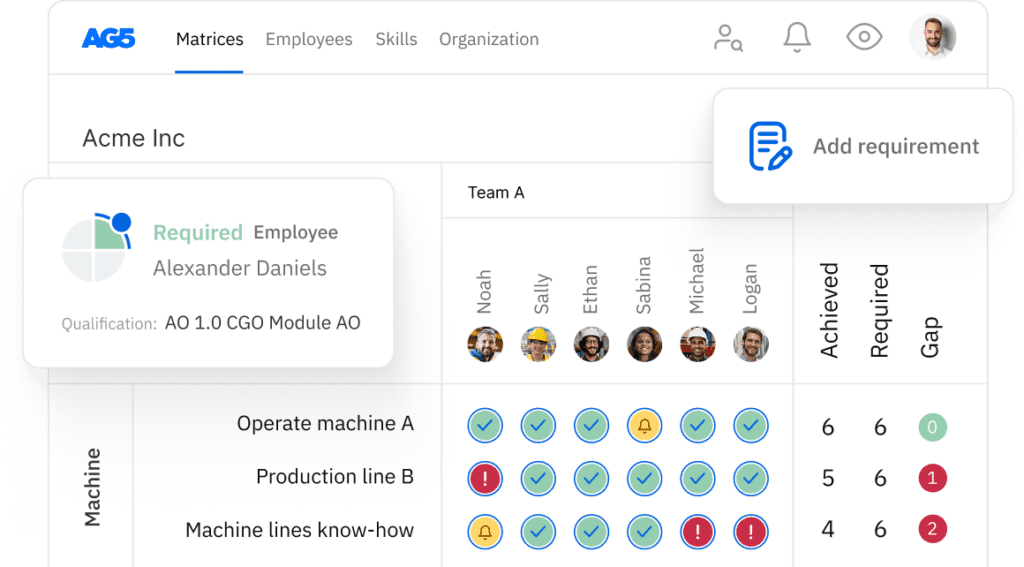What are the benefits of measuring employee skills data?
In this article, we discuss the benefits of measuring employee skills data. It explores how such data can inform strategic decision-making, enhance workforce management, and drive organizational success.

In conversation: AG5’s CEO Rick Van Echtelt & David Green on the Digital HR Leaders podcastCopied
Our CEO, Rick Van Echtelt joined David Green in conversation on the Digital HR Leaders podcast. During their discussion, they reflected on the value of measuring skills data and how companies should address it. According to the World Economic Forum’s, 50% of all employees will need to be reskilled by 2025. This same study predicts that 97 million new jobs will emerge and a further 85 displaced due to a shift in labour between humans and machines, which, as Rick and David note, is all the more reason to get a firm grip on your skills data. A task that isn’t as simple as it sounds, as Rick discovered during AG5’s infancy stage.
Many commentators have thrown light on the importance of skills management these last years, responding to how the global pandemic accelerated this overturn of labour. One report from McKinsey found that 79% of CEOs have placed skills management high on their agenda, as they are concerned about how skill availability will impact their organizations. The main concerns raised are the potential negative impact on four key areas: innovation, cost, quality, and growth.
How Skills Management Software can help get a handle on skills data
AG5’s mission is simple: deliver software that helps visualize and close skill gaps. It does this by providing an accounting system of skills that aggregates data from multiple systems, maps current skills, tracks learning development, and identifies which skills are missing for current or future operational and business requirements.
In conversationCopied
During their conversation, Rick and David addressed the following topics:
- how challenging getting your skills data under control can be
- the value of measuring skills data and the best ways companies should do it
- the multiple benefits of having a skills-based view
- how AG5 help their clients stay compliant by visualising and closing skill gaps
What challenges are you trying to solve for customers at AG5?
We provide software that allows our customers to easily manage their skills data. Our software centralises all skill related information – qualifications, certificates, and so forth – so that organizations can easily identify competencies and potential skill gaps. Not only does this help optimize the day-to-day operations, it also ensures that organizations stay compliant and ready for the future.
“The first factory had 300 people. They had this Excel with around 10,000 skills results in it. So that is more than 30-40 skills per person.”
The big problem we identified early on, long before the “reskilling revolution”, is that skills data is often logged across multiple systems and spreadsheets. Workforces grow. But so also do skills, especially in the face of innovation. This means that data is no longer just widespread, it’s also more complicated. Before we even consider personal development, we need to bear in mind that an average employee has around 30-40 skills. So, from the get-go, trying to manage the skills of an entire workforce can be difficult. When we factor in growth and development, skill management can very quickly become unmanageable. And by not having a strong grip on your skills data you run the risk of underperforming. You also run the risk of having a non-compliant business, which is much worse.
How have you researched the challenges manufacturing companies face?
When we started, let’s say 10 years ago, we quickly discovered that manufacturers were running busy skills matrices with loads of data. We also discovered that these matrices were complicated and extremely different from one another. Even though they all had an LMS system, SAP SuccessFactors, and e-learning systems in place, they were still creating skill matrices through Excel. Why? We asked. It turned out it wasn’t just for L&D purposes but also for auditors and planning. “Excel was just the tool they knew,” many organizations told us. Even though their skills matrices were becoming more and more unmanageable, they stuck with it. We had to solve the problem.
Why do you think skills are such a hot topic today?
As every industry is now impacted by technology, you see plenty of jobs on the market which require new skills. There are also loads of jobs disappearing and becoming redundant because of these advances. People are aware of this shifting landscape and know they need to do something about it. This is a big reason why skills have become such a hot topic today.
Who, in your view, owns skills in the organization?
First of all, I think you as a person, as an employee, take ownership of your skills. You are responsible for your own career. However, organizations need to support their employees as best they can through skill analytics and development. The problem for many though, is that their skills data is recorded across many different systems and spreadsheets. They just don’t have the optimum skills infrastructure to support their teams. This is where we can step in to help. AG5 software helps employees understand how their skills fit in the organization and the areas where they can develop and grow.
What is the impact of poor skills management?
Poor skills management can impact many aspects of a business. However, there are three core areas of concern for many organizations: turnover, revenue, and safety. Nowhere feels this more than production lines. To give an example, if an under-skilled employee gets the mix wrong in an ice cream plant the whole process will need to be stopped. The machinery will need to be cleaned, the product inspected, and if the faulty batch has left the site then a recall will need to be issued. The impact will be costly.
“Some skills can impact turnover, some skills can have an impact on costs or risks and some skills will impact safety.”
Why do you think organizations are struggling to get a handle on skills data?
Many companies are now calling skills currency the new currency. But the problem with this currency is that you can’t just grab it from one system. It’s in many places. So, how can you get a firm grip on your data when it’s so widespread and unorganised? You just can’t.
This doesn’t just impact the day-to-day running of an organization, it also makes forecasting and planning difficult and ineffective. The best thing an organization can do, then, is to address the problem and bring in a skills accounting system to consolidate all their skills data in one place.
What business outcomes are possible through a skills-based view of the workforce?
We’ve already helped many companies save hundreds of hours a month and cut down on mistakes by providing them with an intelligent skills system. Our clients are in control of their data and have the tools they need to know where they’re at and where they should be. Importantly, they can visualize and close their skill gaps through our software.
What is the value of measuring employee skills data and how should companies approach it?
The approach should always be to start small. Start where the pain is, where people really feel it. This gets you results, fast. Getting in control of your data and passing it on to team leaders who can then take charge of their team’s skills is important. It’s empowering.
Our research has also proven that employees are more motivated when they can measure their own success through the AG5 app. It has been the first time for many employees to see their skills and knowledge logged in one place. Seeing all of their certificates and qualifications, while tracking progress against certain role requirements or goals for professional development, allows them to be proud of what they’ve achieved.
What are the key takeaways of running a Skills Management Software?
AG5 ensures that your skills data is always accessible and readily available when you need it. Our software provides HR, Training, and Operations Managers with a clear overview of their staff’s skills and qualifications. By running our software, companies also ensure compliance and audit readiness. So not only do we drive operational excellence, but we also strive for safety.
Here is how:
- skills data will no longer be fractured and hidden across multiple Excel spreadsheets.
- skills matrices can be generated at lightning speed to make all skills data clear and usable.
- operational decisions become easier as the necessary skills information can be in the hands of those that need it when they need it.
- knowing precisely what your employee’s skills and qualifications are means that you’ll stay compliant within your different job and process requirements.
You can take a look at the entire episode here.

